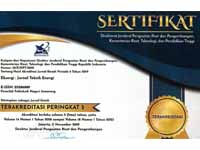Teknologi Pembangkit Listrik Energi Baru Terbarukan Menggunakan Proton Exchange Membrane (PEM) Fuel Cell Skala Kecil
DOI:
https://doi.org/10.32497/eksergi.v15i1.1464Keywords:
fuel cell, pembangkit listrik, konsentrasi KOHAbstract
Penelitian ini bertujuan untuk menguji dan menganalisa unjuk kerja paling baik PEM Fuel Cell terhadap pengaruh laju aliran gas hidrogen dan oksigen. Metode yang digunakan dari studi literatur dan pengumpulan data untuk mendesain alat, disertai bimbingan dengan dosen agar hasilnya maksimal. Setelah itu, barulah diadakan pengadaan bahan untuk proses pembuatan alat agar dapat diuji. Pada pengujian elektroliser dilakukan variasi konsentrasi KOH dan arus input, sedangkan pada pengujian fuel cell dilakukan variasi laju aliran gas H2 dan O2 serta beban menggunakan lampu LED dioda. Dari hasil pengujian dan perhitungan elektroliser jumlah produksi gas hidrogen paling tinggi pada konsentrasi 2M dengan arus 20A sebesar 189,3 ml dan efisiensi tertinggi sebesar 93,5% . Dari data tersebut digunakan untuk menguji fuel cell. Pada fuel cell efisiensi tertinggi dan unjuk kerja paling bagus ada pada pemberian input gas H2 0,81 ml/s dan O2 0,45 ml/s dengan nilai efisiensi 4,25% dan nilai SFC 0,7 kg/kWh.
Downloads
Published
Issue
Section
License
Authors who publish with this journal agree to the following terms:Authors retain copyright and grant the journal right of first publication with the work simultaneously licensed under a Creative Commons Attribution License that allows others to share the work with an acknowledgement of the work's authorship and initial publication in this journal.
Authors are able to enter into separate, additional contractual arrangements for the non-exclusive distribution of the journal's published version of the work (e.g., post it to an institutional repository or publish it in a book), with an acknowledgement of its initial publication in this journal.
Authors are permitted and encouraged to post their work online (e.g., in institutional repositories or on their website) prior to and during the submission process, as it can lead to productive exchanges, as well as earlier and greater citation of published work (See The Effect of Open Access).






